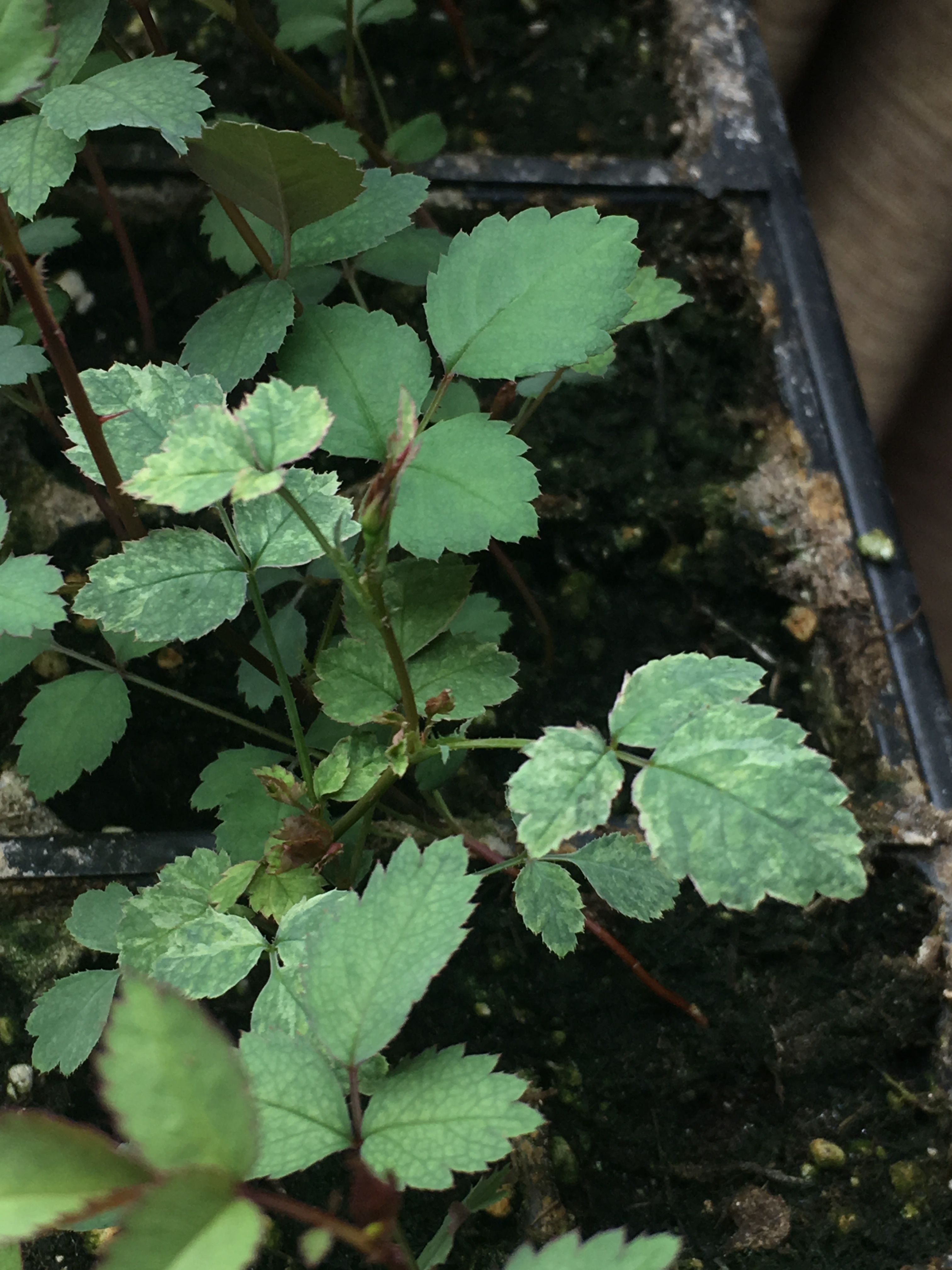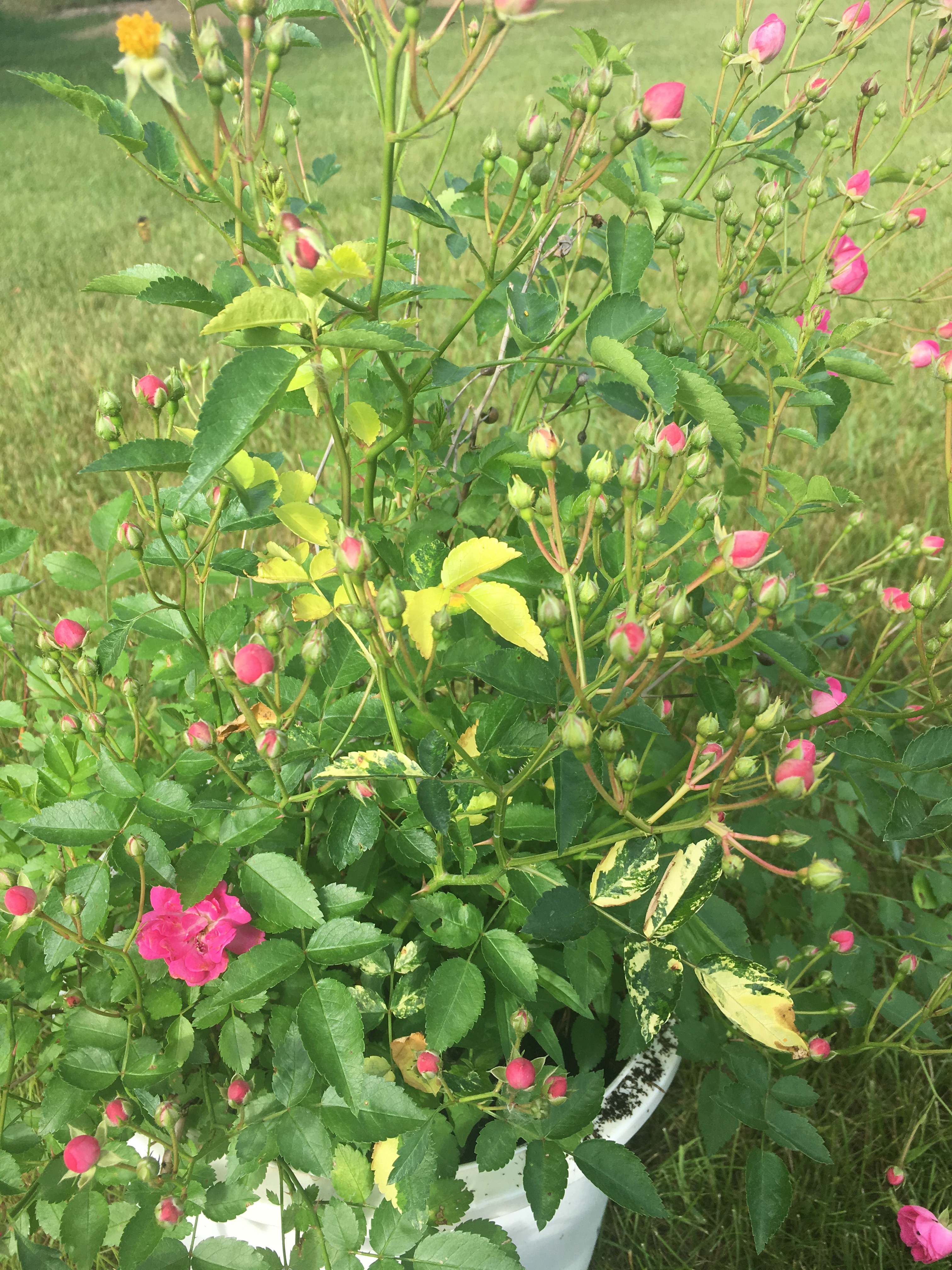Does anyone have any experience with breeding roses for/with variegated foliage? I was thinking of buying R. wichurana variegata for my hobby, any info about breeding R. wichurana as well would be helpful!
My only venture into variegated foliage were the odd mutants which resulted from selfs from Schoener’s Nutkana, thirty-plus years ago. Good luck.
I’ll just follow up with the question: Do folks know if any of the known variegated foliage plants pass on genes for such, or are most such chimeras caused by something other than inherent genetics?
I have never encountered a variegated foliaged plant which transmitted foliage variegation to its offspring. That includes Curiosity, Verschuren and John Clement’s miniature with variegated foliage which sported from Britestripe. The only variegated foliated seedlings I have raised were the selfs from Schoener’s Nutkana.
Thanks, Kim. That’s what I was thinking too.
According to a breeder posting on HelpMeFind, ‘Verschuren’ has produced some seedlings with variegated foliage: 'Verschuren' Rose Photo (also see the member profile where he reiterates this, at Member Profile). I didn’t find any photos of the seedlings themselves.
Because of the sectoral variegation, I would speculate that it might only transmit when used as a seed parent, with best results probably to be expected from flowers that have visible streaks of variegation extending into the hip (one image on HMF shows this clearly).
Stefan
Cool! I’m not familiar with that one. It might become the Ferdinand Pichard of foliage.
It’s a very fragrant old, pink HT with variegated foliage. It grew OK own root and would probably make a rather nice plant budded. It never resulted in anything of note for me.
For some years my impression had been that variegated foliage in plants was inherited through faulty chloroplasts in a non-Mendelian fashion, and generally maternally inherited (similar to how mitochondrial issues are inherited in humans). Such maternal inheritance is thought to account for variegated foliage in Brassica rapa and I believe it has been found in various other species as well.
However, contrary to my previous understanding that variegated foliage was always inherited through faulty chloroplasts, I have read that in some cases a variegated phenotype may be inherited through the nuclear genome, an example of this being found in Brassica campestris. Thus, it appears that variegated foliage may be inherited in a non-Mendelian fashion (through chloroplasts) or a traditional fashion (through the nuclear genome), with different modes of inheritance in different species.
Stefan earlier suggested that the chance of variegated rose seedlings would likely be higher from branches with a notable degree of variegation, and if variegated foliage in roses is inherited through faulty chloroplasts (non-Mendelian), I believe that is a very valid point. For an interesting example of this in cowpeas, see Maternal inheritance of plant variegation in cowpea, Vigna unguiculata (L.) Walp. | SpringerLink .
You guys are starting to make me think this is a wall worth beating ones head against… But I have enough scatter-brained ideas, I am NOT going to venture there…
Came across this photo of a variegated sport of Francis Meilland/Prince Jardinier on HMF:
Rather striking, IMO, and if stable, would have been worth marketing…
That sport has glimmers of what could make a great variegated rose, although the badly burned white margins probably give away a commercially fatal flaw in this particular stage. You could probably continue to promote and select from that sport until a better one emerges, though, and it may eventually “settle down” by producing a relatively burn-resistant variegated clone with some careful work along the way. Strictly marginal variegation tends to be rather stable through vegetative propagation (also, sadly, almost never sexually heritable) Sometimes relatively sun- and heat-tolerant variegated clones can be stabilized from ones that burn badly through further carefully managed growth and clonal selection.
By contrast, sectoral (irregularly “streaked” and/or “blotched”) and “diffuse” (smaller but more evenly distributed across the leaf, i.e., looking more like spider mite damage) variegates tend to be more naturally burn-resistant, up to a point; those types of variegation are also much more often sexually heritable. Of course, sectoral variegation is typically the least stable type, and the apparent stability of variegation in ‘Verschuren’ over the long time it has been in commerce is actually pretty remarkable. It’s begging to be played with, even if the results only tickle a tiny niche market.
Roses with dark, reddish or purple foliage or golden leaves also remain elusive, but those are common enough in other plants that it is just a matter of time before the traits appear and can be exploited. If genetic engineering wasn’t so stigmatized and excessively regulated, those traits might already be incorporated (and that would just be the tip of an iceberg of possibilities, of course.)
Stefan
I love the look of the Fracis Meilland sport! With the edges being more consistently white, I wonder if it is a periclinal chimera with just the outermost layer of the growing point being mutated to not produce chlorophyll.
I suspect mutated chloroplasts may be the reason for the attached variegated seedling on the plant stand right now. There are a handful all from the same mom. It has R. wichurana as a great grandmother. Maybe that R. wichurana is related to the variegated R. wichurana on the market or is just prone to the same kind of mutation??

Speaking of potential, that’s going to be one to watch, David! The variegation doesn’t look too much like that of R. lucieae ‘Curiosity’ to my eyes, but it does look like a pretty stable quasi-marginal distribution pattern that will probably hold up to sun and heat, and the contrast may well intensify a bit outdoors. Also, again less like ‘Curiosity’, that type of pattern in plants usually doesn’t fade as the leaf ages.
Since foliage variegation is such a nonexistent novelty among contemporary rose introductions, it could potentially garner some real interest on the market. High disease resistance would be a must since more attention is to be focused on the leaves, and the effect of both flowers and foliage would be good to consider. A highly variegated ‘Radrazz’ (Knockout) sport could probably cause seizures, although I suppose it would also probably sell like nobody’s business.
Stefan
Hi Stefan! :0) I’ll do my best to keep it going and post some follow ups when it blooms. It has a flower bud set. A variegated Knock Out would sure be pretty with the nice otherwise dark leaves and richly colored flowers. This polyantha’s mom is a single blush white. It would sure be fun to have a richer pink flower for contrast.
A couple new Poulsen Parade roses are striped flowers with gorgeous form. Gigi Parade (red and white stripe) and Tijana Parade (pink and white stripe.) I get mine at Trader Joe’s and they may be available at Home Depot or your local supermarket.
Any updates on this seedling? ![]()
It is a bit slower growing and weaker and it is a single soft pink.
Could you keep me updated with pictures? I’m super interested in this c:
The variegated seedlings from this spring posted above for the most part don’t look too healthy. The variegation seems to be less pronounced than before and lead to the leaves being smaller and kind of mottled and off color. I shared some for virus testing and it’ll be interesting if something is found.
Anyways, today as I was looking at a plant of my Pretty PollyTM Pink there was a variegated sport! One branch went all yellow and there was a number of leaves that were part green and part yellow/white. It seems like an unstable variegation, unfortunately. It was a fun surprise to see this today.
